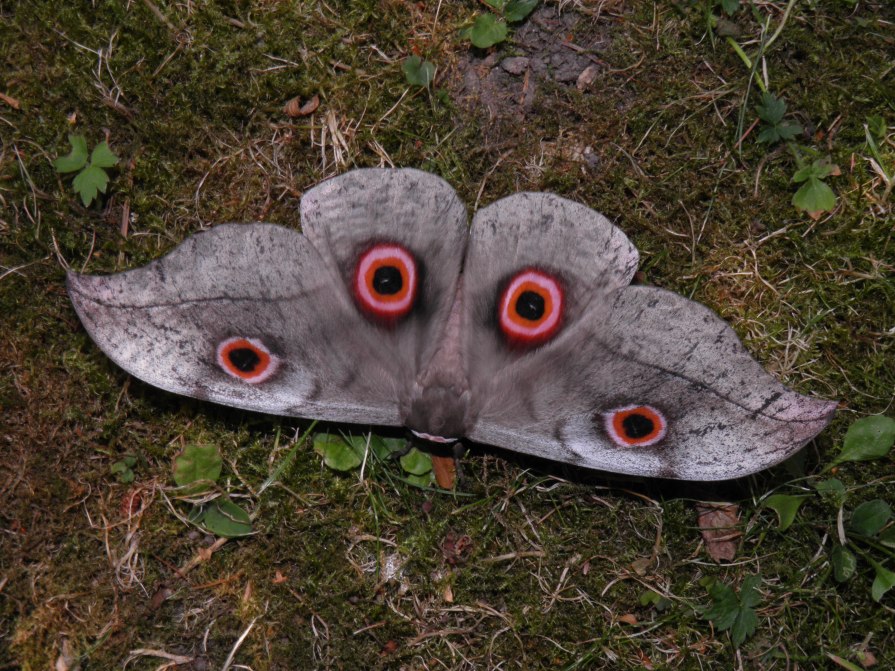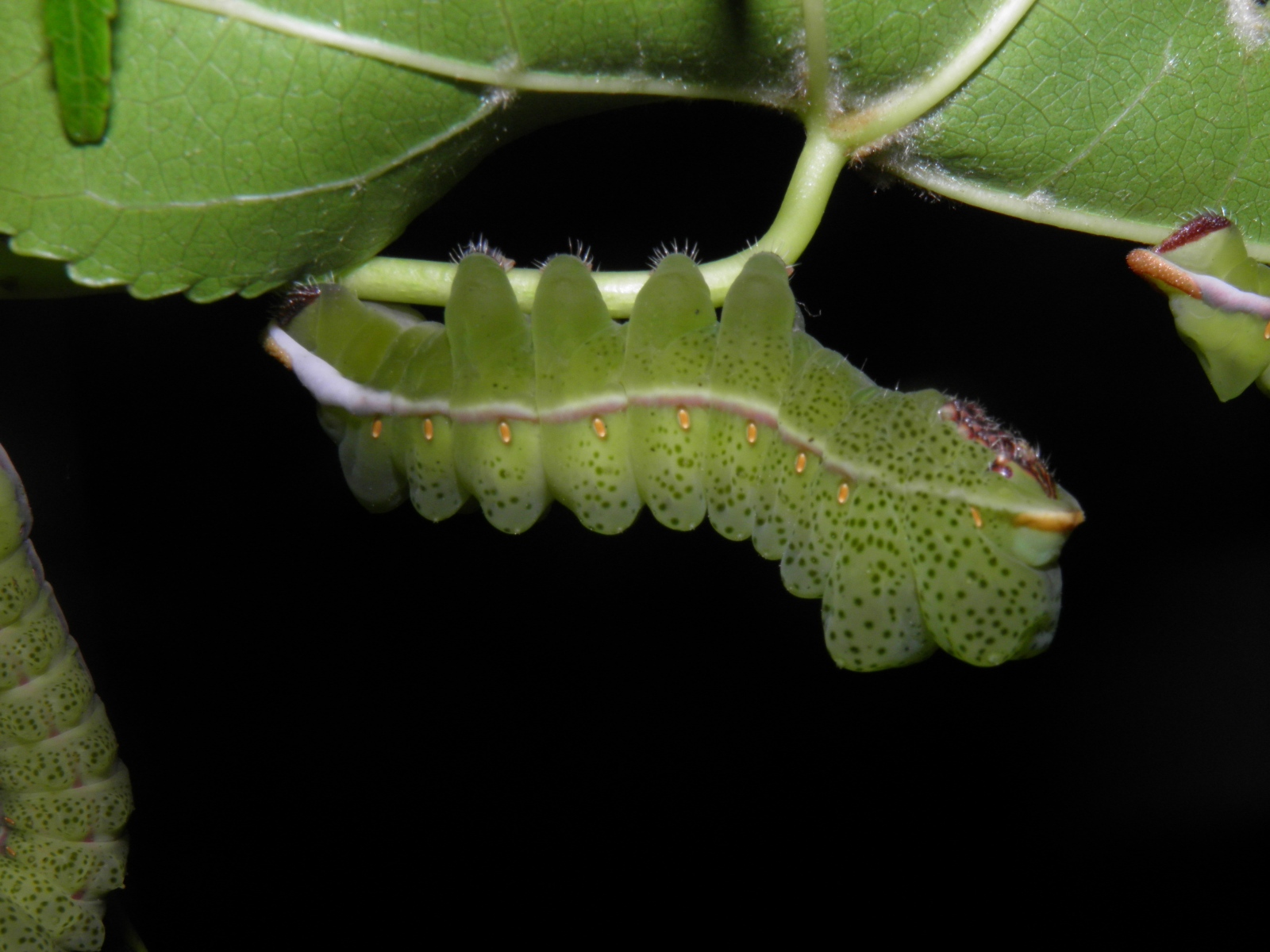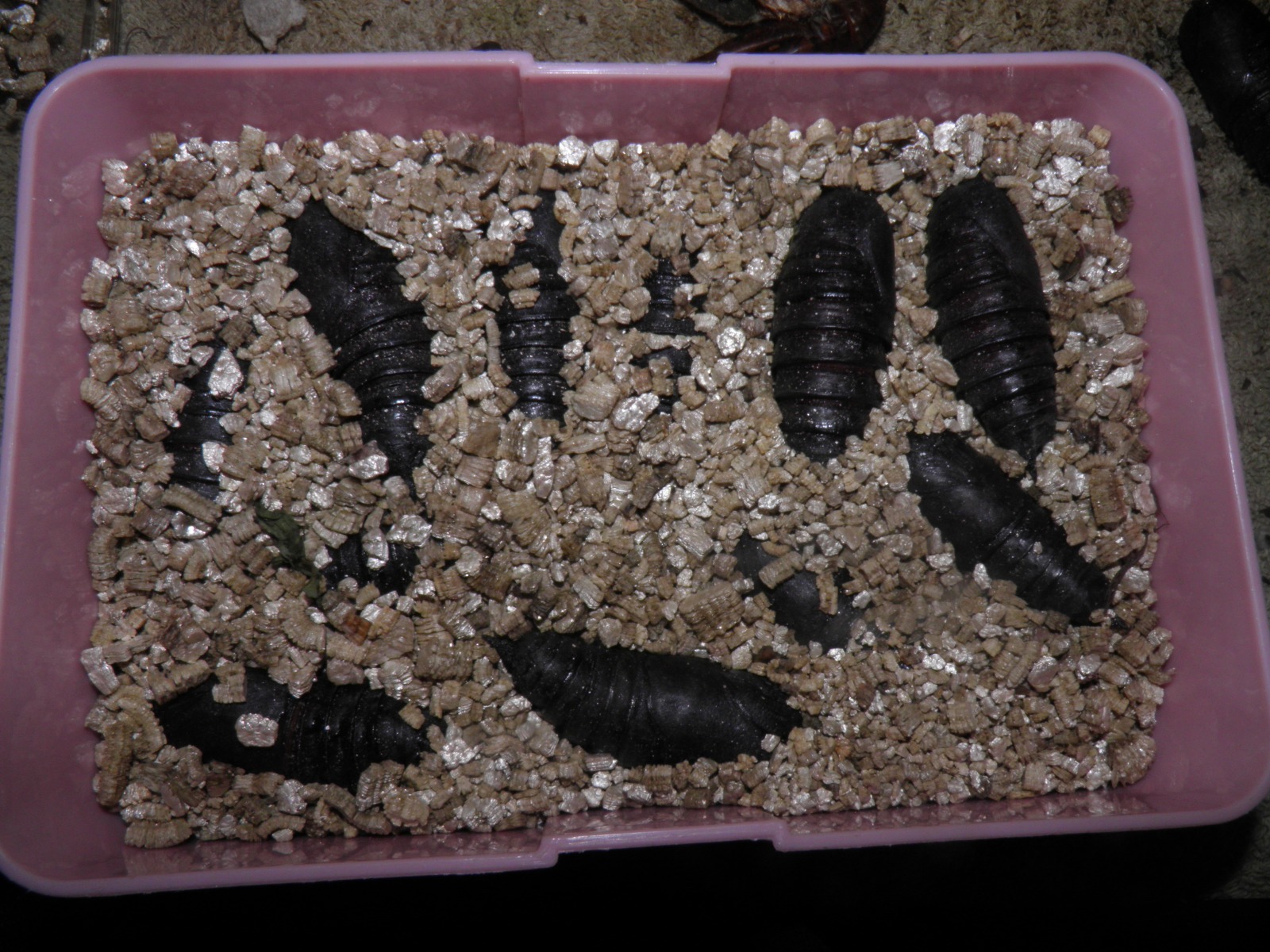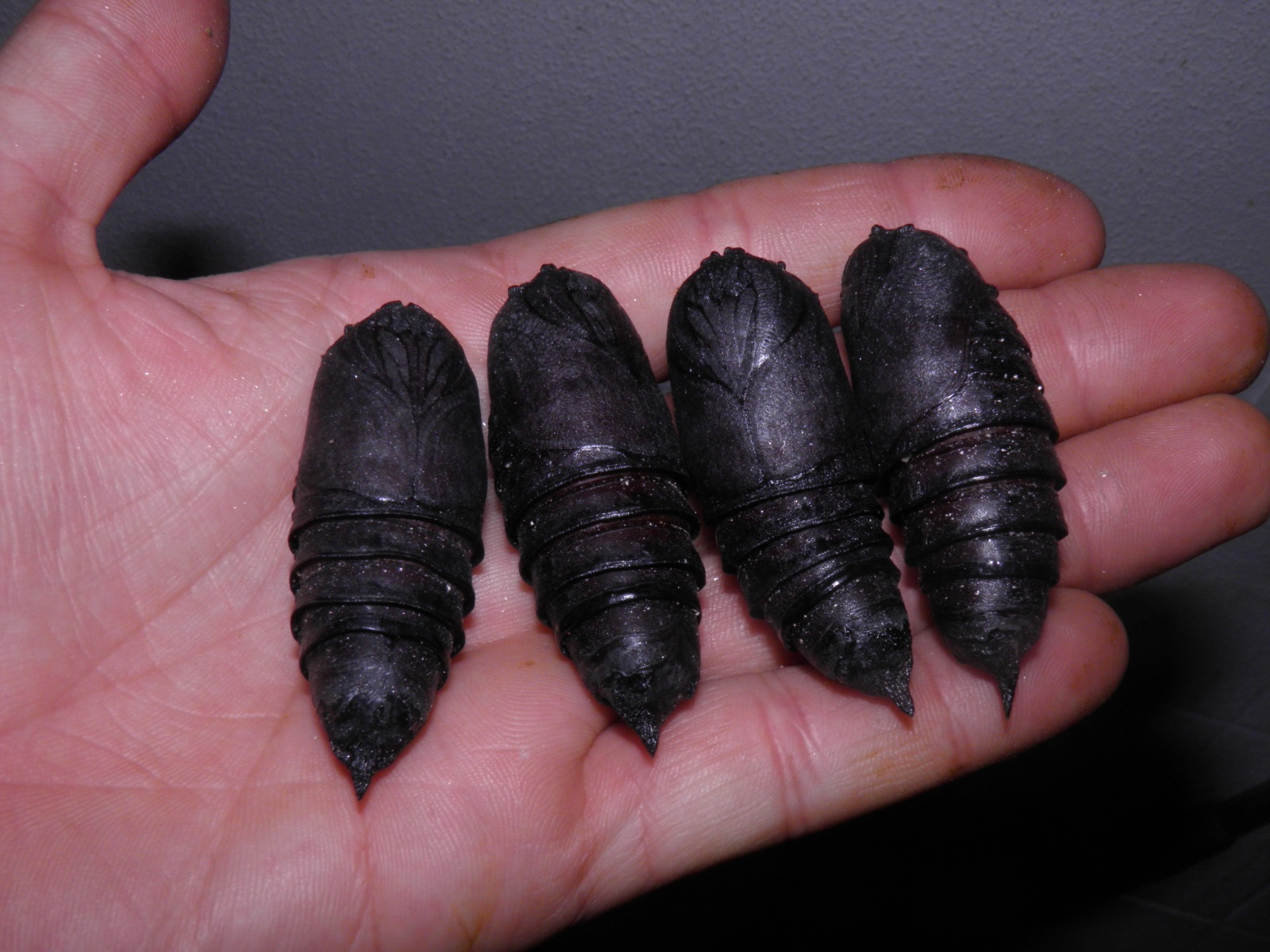Lobobunaea christyi or Lobobunaea phaedusa christyi is an very impressive species of Saturniidae silkmoth with extremely intense, bright red eyespots. It is found in western equatorial Africa; it is reported in Mali, Togo, Burkina Faso, Cameroon,Kenya, Uganda, Senegal, Ethiopia and quite likely more places. However, it is unclear because there is a lot of confusion about this moth. This is because it remains unclear if Lobobunaea christyi is a valid species at all. In fact, many people regard it as a subspecies of Lobobunaea phaedusa (aka Lobobunaea phaedusa ssp. christyi). This may be very confusing, because some literary sources that present records of this species also report the full range of the nominate Lobobunaea phaedusa, not considering the fact they could be separate species.
The appearance of Lobobunaea christyi and Lobobunaea phaedusa is visually very different; Lobobunaea christyi has red eyespots on the forewings while Lobobunaea phaedusa does not. Both species have red eyespots on the hindwings, however. This website treats both moths as seperate species, for sake of comparison when I have bred both types – I also regard them as seperate species.
 Male and female of Lobobunaea christyi.
Male and female of Lobobunaea christyi.
The female of Lobobunaea christyi is slightly larger than the male. Males also tend to have darker, more “purple”-ish eyespots while the females eyespots are a lighter more “pink”-ish type of red. Males have thicker antennae and less thick bodies. The moths open their wings if disturbed, revealing the eyespots – but when resting they fold their wings together.
Lobobunaea christyi appears to have multiple generations per year – their emergence is triggered by increased humidity after a dry period, which signals the start of the wet season. After hatching the moths pair and lay 50 to 150 pale white and round eggs. These eggs hatch in about 2 to 3 weeks time (slightly longer than most Saturniidae). The caterpillars are social in the first three instar, but the 4th and 5th instar become solitary. They feed on a very large variety of plants and are fully grown in 1.5 to 2 months time. The caterpillars do not spin cocoons but burrow in the soil and pupate in a subterranean chamber. It is very possible to breed them in captivity, although they may prove to be a challenging species.
- Difficulty rating: Hard (unpredictable species, even experienced people can struggle with them)
- Rearing difficulty: 8/10 (From egg to pupa)
- Pairing difficulty: 8.5/10 (Archieving copulations)
- Host plants: Rosa sp. (roses), Quercus sp. (oak), Prunus sp. (cherries), Croton mubango, Vitex madiensis, Acacia sp. (acacia), Crossopteryx febrifuga, Sclerocroton cornutus, Dacryodes edulis (safout), Sapium ellipticum, Crossopteryx febrifuga, Ligustrum sp. (privet), Anona sp. (such as senegalensis, African custard apple and muricata aka soursop), Psidium guajava (guava), Liquidambar styraciflua (sweetgum), Salix sp. (willow), Rhus sp.(sumach), Juglans sp. (walnut), Uapaca sp., Eucalyptus sp and many more
- Natural range: Mali, Togo, Burkina Faso, Cameroon,Kenya, Uganda, Senegal, Ethiopia and quite likely more places (Tanzania, Zambia?)
- Polyphagous: Very polyphagous, accepts many Rosaceae, Fabaceae, Fagaceae, Euphorbiaceae, Salicaceae, Altingiaceae, Annonaceae, Anacardiaceae, Rubiaceae and in fact many more families of trees and shrubs.
- Generations: Multivoltine – multiple generations a year, depending on the conditions
- Family: Saturniidae (silkmoths)
- Pupation: Subterranean
- Wingspan: 145 – 200mm (very large)
- Binomial name: Lobobunaea christyi (Sharpe, 1889) or Lobobunaea phaedusa
(Drury, 1872) ssp. christyi
The first and second instar caterpillars are bright yellow with black stripes. Both instars look extremely similar, although second instar larvae have a red head capsule while first instar larvae have a black head capsule. After hatching they will form groups and roam the vegetation together, feed together and shed their skins together.
 Lobobunaea christyi first instar (L1)
Lobobunaea christyi first instar (L1)
 Lobobunaea christyi second instar (L2)
Lobobunaea christyi second instar (L2)
The first and second instar are not very picky and can be raised in plastic boxes such as tupperware but also cricket tubs. They can also be sleeved on their food plant or can freely feed from cut food plant in a water bottle.
In the third instar the caterpillars finally turn green, with orange spine-like setae on their body and four large black setae on their thorax with red head capsules. This instar is also social and they will hang out with other L3 and smaller caterpillars. From this instar and beyond they should be put in a cage or a sleeve with plenty of air flow/ventilation for them.
 Lobobunaea christyi third instar (L3)
Lobobunaea christyi third instar (L3)
The fourth and fifth instar look nearly the same; the larvae become smooth with no tubercules, chubby and green with dark green dots. The fifth instar is larger than the fourth and seems to have a slightly lighter green colour although this can vary wildly.
Is it a difficult species?
Difficult question. I have completed their full life cycle multiple times, so I guess they can not be that difficult. However, Lobobunaea seems to be very finnicky. In many cases, broods show high mortality rates (often over 90%) on various food plants, even if they are not infected. That is why I prefer to breed this species starting with a high number of individuals – at best 100 to 200 eggs from multiple pairings or wild females.
I think the problem is the fact they tend to be out of their comfort zone fast in captivity. The first problem is that the larvae are very polyphagous and will try to eat most plants you provide them – even if the food plant in question is not really great for them. The second problem is that they probably need a little more warmth, and they could be slightly out of their comfort zone on room temperature. The third problem is that they are a little sensitive to diseases and infections. While blogs like these can make it look straightforward and easy, I think many people will struggle to raise some at all.
Results also seem unpredictable – sometimes you will fail and sometimes you will have succes using the same rearing method and setup. Perhaps some bloodlines are better adapated to certain plants than others. Succes never seems to be guaranteed with Lobobunaea. Despite that it is very possible to breed them with some luck and skill. Note that this is a personal observation and different per person – some people may use a different method and find them easy! However, I find it one of the more difficult species to rear and pair. For the best result, roses (Rosa), oak (Quercus), sweetgum (Liquidambar), privet (Ligustrum) can be used in captivity outside of their native range. Prunus (padus, serotina) and willow (Salix) works oo.
After 1.5 to 2 months time the caterpillars will be fully grown, and need to burrow in substrate. Examples such as vermiculite, peat, soil, bird sand or simply moist shredded paper towels can be used.
Pupae should be stored warm(ish) although they can tolerate cooler temperatures around 15C. It is not advised to keep them colder than this. The optimal temperature is really around 22C-25C however. Their emergence is however not only triggered by temperatures, but rather by humidity. Since these moths hatch at the start of the dry season, they want to be kept dry for several months, only to wake up after a sudden wet period. One way to do this is to keep them in a dry and cool room for multiple months, and then suddenly move them to a warmer room and spray them with warm water several times a day to keep them wet. However if not provided such circumstances they will usually hatch in summer in captivity anyways, triggered by the warmth.
Pairing Lobobunaea
Lobobunaea can be difficult moths to pair. In many cases males will totally ignore females or stuggle to find them. Some individuals seem to be much more interested in pairing than others; I had males that paired with multiple females instantly for example, while I’ve also had males that refused to move much at all. While this species can be handpaired if you know how to do it, I’ve always tried to get natural pairings. The moths will have the best chance of pairing in a warmer, well-ventilated, dark environment – such as outside in the garden during a warm summer night. Do not put more than one pair in one cage, or they will have a tendency to disturb and bump into eachother, something that can distract them from copulating because of their great size. It seems no matter how many I breed, a good percentage of males and females will ignore eachother and not pair – no matter what. For that reason it is good to have a higher number of pupae to increase your chances; one pairing resulting in 100 to 150 eggs will make up for the loss of the non-pairing individuals. It also seems they are warmth loving moths that like warm to hot nights, and do not like to be disturbed too much during the day or night. They also need ventilation and space – too many females in the same area (even if not in the same cage) will confuse the males.
The best succes I ever had with pairings, was during a heat wave in summer in the Netherlands – in August 2018 two record breaking heat waves turned my usually chilly little country into an oven for a few weeks. During these nights, I paired more couples of Lobobunaea christyi than I ever did before. This is strong evidence to me that this species is one that greatly appreciates warmth and in particular warm nights. It could be that room temperature is a little bit below their prefered temperature.
 Lobobunaea christyi copulation (pairing) – natural pairing
Lobobunaea christyi copulation (pairing) – natural pairing
Video:
The moths are often pictured with their wings open since their eyespots are their most attractive feature. However in the resting position of this moth, the wings are closed and folded together. They only briefly open their wings after they have been disturbed, only to close them again a few minutes later.
 Lobunaea christyi; natural resting position
Lobunaea christyi; natural resting position
 Lobobunaea christyi threat pose (female)
Lobobunaea christyi threat pose (female)
 Lobobunaea christyi threat pose (male)
Lobobunaea christyi threat pose (male)
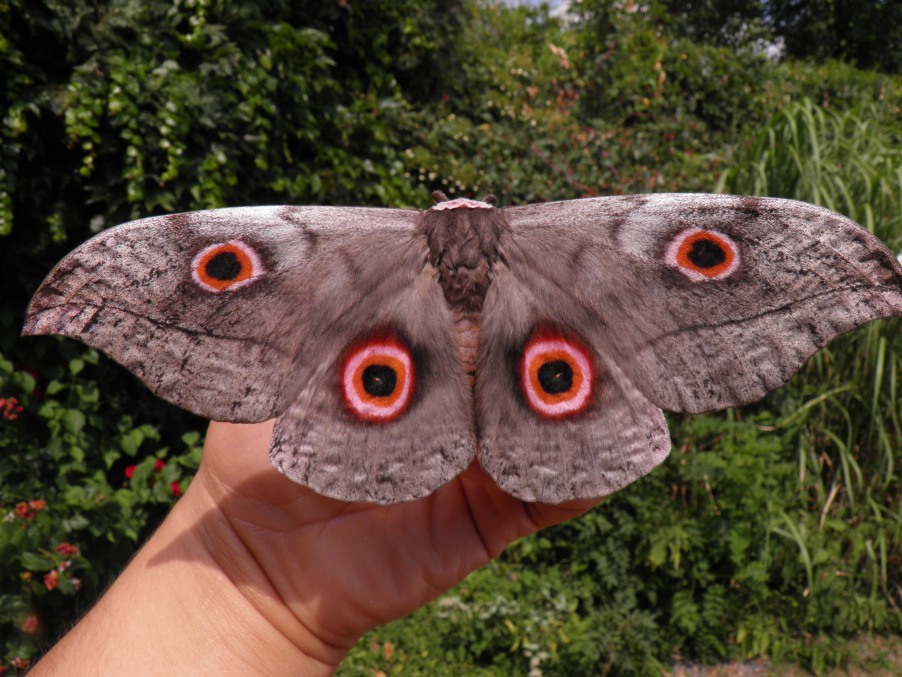 Lobobunaea christyi threat pose (female)
Lobobunaea christyi threat pose (female)
Overall, Lobobunaea christyi is one of the most beautiful Saturniidae to breed in captivity. And although they can be a challenge, their food plants are very convenient.
Thank you for reading my article. This is the end of this page. Below you will find some useful links to help you navigate my website better or help you find more information that you need about moths and butterflies.
Dear reader – thank you very much for visiting! Your readership is much appreciated. Are you perhaps…. (see below)
-
-
- Not done browsing yet? Then click here to return to the homepage (HOMEPAGE)
- Looking for a specific species? Then click here to see the full species list (FULL SPECIES LIST)
- Looking for general (breeding)guides and information? Then click here to see the general information (GENERAL INFORMATION)
- Interested in a certain family? Then click here to see all featured Lepidoptera families (FAMILIES)
-
Citations: Coppens, B. (2019); Written by Bart Coppens; based on a real life breeding experience [for citations in literature and publications]
Was this information helpful to you? Then please consider contributing here (more information) to keep this information free and support the future of this website. This website is completely free to use, and crowdfunded. Contributions can be made via paypal, patreon, and several other ways.
All the funds I raise online will be invested in the website; in the form of new caresheets, but also rewriting and updating the old caresheets (some are scheduled to be rewritten), my educational websites, Youtube, breeding projects, the study of moths andconservation programs.
Donate button (Liberapay; credit card and VISA accepted)
Donate button (PayPal)
![]()
Become a member of my Patreon (Patreon)
![]()
Find me on YouTube

Find me on Instagram
![]()
Join the Discord server: Click here
Join the Whatsapp server: Click here
Buy insect cocoons: Click here
Facebook: Click here

